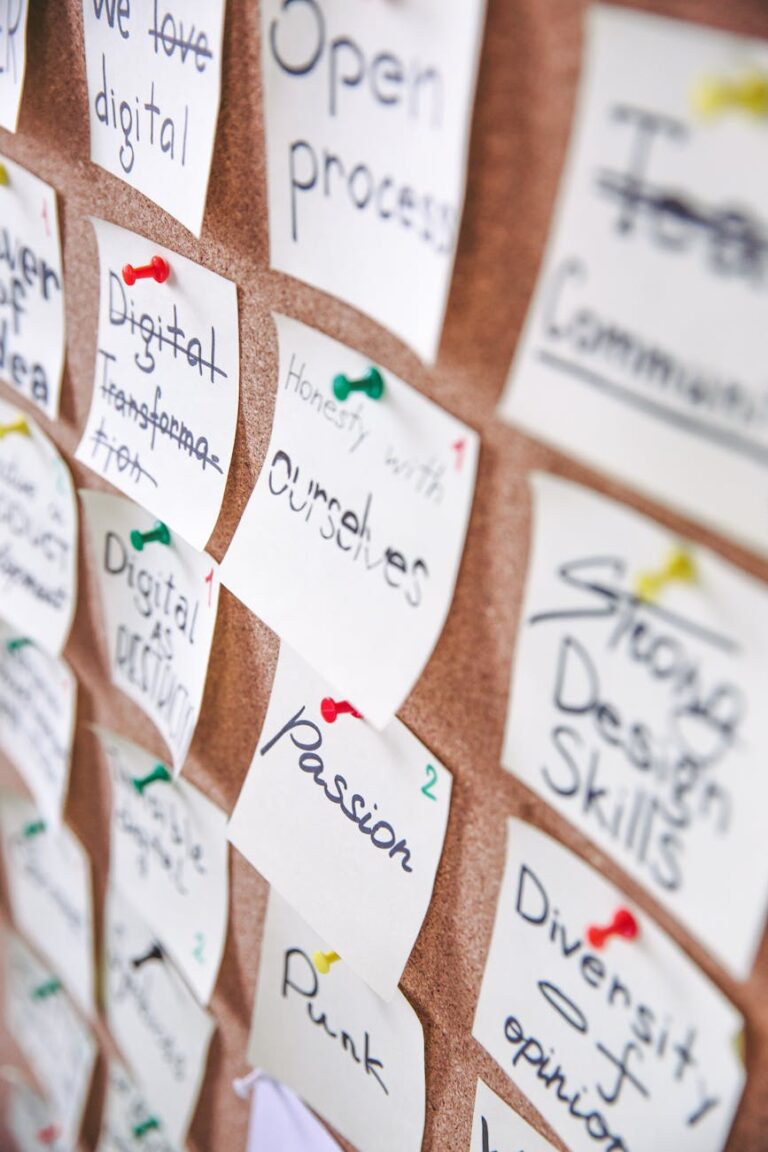Top 2025 Tech Trends Driving Business Growth
Navigating the Future: Unpacking the Top 2025 Tech Trends for Business Growth
Estimated reading time: 12-15 minutes
Key Takeaways
- Prioritize speed, performance, and user experience in both web and mobile solutions to stay competitive.
- Embrace cloud computing and DevOps practices for scalable infrastructure and efficient development cycles.
- Strategically integrate AI automation to streamline repetitive tasks, reduce costs, and enhance customer satisfaction.
- Adopt a flexible and modern tech stack that allows for adaptability and future growth.
- View these technological advancements as interconnected components of a comprehensive digital transformation strategy.
Table of Contents
- The Dynamic World of 2025 Tech Trends: A Deep Dive
- Bringing It All Together: Your Blueprint for 2025 and Beyond
- Accelerate Your Digital Future with AITechScope
- FAQ
The digital landscape is in a constant state of flux, with innovation accelerating at an unprecedented pace. For business professionals, entrepreneurs, and tech-forward leaders, understanding and adapting to these changes is not just an advantage—it’s a necessity for survival and growth. As we cast our gaze towards the horizon, the 2025 tech trends reveal a future rich with opportunities, where strategic adoption of technologies like advanced web development, mobile app innovation, robust cloud and DevOps practices, intelligent AI automation, and intuitive UI/UX design will redefine business success. At AITechScope, we believe that staying ahead requires not just awareness, but a proactive strategy to integrate these powerful tools into your operations, driving digital transformation and unparalleled efficiency.
The upcoming year promises a significant evolution across various technological domains. From how we build websites to how we manage our data and interact with customers, every aspect of the digital realm is being optimized, automated, and made more intelligent. This comprehensive guide will dissect the most impactful 2025 tech trends, offering insights, practical takeaways, and demonstrating how expert AI automation and consulting services can help your business thrive in this dynamic new era.
The Dynamic World of 2025 Tech Trends: A Deep Dive
1. The Evolution of Web Development: Speed, Intelligence, and Scalability
Web development is no longer just about building a presence; it’s about crafting high-performance, intelligent, and scalable digital experiences. The 2025 tech trends in this domain emphasize speed, responsiveness, and the seamless integration of advanced functionalities.
Next.js and React Performance: Building the Foundations of Speed
For businesses aiming for a rapid digital footprint, Next.js for small businesses is emerging as a clear winner. Its ability to create a fast marketing site in one weekend is a game-changer, offering benefits like server-side rendering (SSR), static site generation (SSG), and image optimization that dramatically improve page load times. Speed directly impacts user experience and SEO rankings, making it a critical factor for online success.
Beyond initial development, maintaining peak performance is crucial. Simple React performance fixes can reduce page load by seconds, which translates into higher engagement and lower bounce rates. Techniques like lazy loading components, optimizing image delivery, and using memoization are not just developer best practices but direct contributors to business efficiency.
Micro Frontends: Modularity for Scalability
As web applications grow in complexity, the traditional monolithic frontend can become a bottleneck. Micro Frontends offer a solution by breaking down the user interface into smaller, independently deployable units. This approach enhances scalability, allows for independent team development, and simplifies updates. While they offer immense benefits for large-scale enterprise applications, understanding when they help and when they hurt is key. For smaller teams, the overhead might outweigh the advantages, but for growing platforms, micro frontends represent a powerful strategy for sustainable development.
AI-Powered Web Apps: The Future of User Experience
The integration of artificial intelligence is transforming web applications. Making your SaaS smarter with low-effort AI features that delight users is no longer a luxury but a growing expectation. Imagine AI-powered chatbots offering instant support, personalized content recommendations driven by machine learning, or automated data analysis dashboards. These AI-powered web apps enhance user engagement, provide invaluable insights, and automate repetitive tasks, freeing up human resources for more strategic initiatives.
Headless CMS: Freedom and Flexibility
The shift towards a headless CMS WordPress setup offers unparalleled flexibility, decoupling the content management backend from the frontend presentation layer. This means businesses can use WordPress for its robust content editing capabilities while powering their website, mobile app, or even IoT devices with modern frameworks like Next.js or React. The result is WordPress without the bloat, leading to faster, more secure, and highly customizable digital experiences that can adapt to any platform.
Practical Takeaways for Web Development:
- Prioritize speed and performance using frameworks like Next.js.
- Explore AI integrations to personalize user experiences and automate tasks.
- Consider a headless CMS for maximum flexibility and future-proofing.
- Invest in performance optimization techniques for existing React applications.
How AITechScope Helps: Our expertise in Next.js and React performance optimization, coupled with our capabilities in building AI-powered web apps and implementing headless CMS solutions, ensures your digital presence is not just modern but also high-performing, scalable, and intelligent. We craft solutions that embody the best of software development 2025, driving your online success.
2. Mobile App Innovation: Reaching Users Everywhere
Mobile applications remain a cornerstone of digital strategy, and mobile app development 2025 is all about speed of development, cross-platform compatibility, and a focus on intuitive user experiences.
Flutter vs. React Native in 2025: The Cross-Platform Debate
The debate between Flutter vs React Native in 2025 continues to evolve, with both frameworks offering compelling advantages for building cross-platform applications. For businesses, the choice often boils down to specific project requirements, team expertise, and long-term vision. Flutter, backed by Google, is praised for its performance, beautiful UI capabilities, and faster development cycles for complex UIs, making it ideal for creating a simple cross-platform app with Flutter: from idea to Play Store. React Native, supported by Facebook, leverages JavaScript, making it accessible to a wider pool of web developers and excellent for apps requiring native module integrations.
The key is to select which mobile framework for startups or established businesses best aligns with their goals: quick market entry, stunning UI, or leveraging existing developer skills. Regardless of the choice, the ability to develop for both iOS and Android from a single codebase significantly reduces development costs and time to market, a critical factor for tech innovation for small businesses.
Mobile App UI Trends: User-Centric Design
The best mobile apps are those that are not just functional but also delightful to use. Mobile app UI trends in 2025 emphasize clean, minimalist design, intuitive navigation, dark mode options, and advanced haptic feedback. The focus is on creating a seamless and engaging user experience that makes interactions feel natural and effortless. Attention to detail in responsive UI design ensures a consistent experience across various devices and screen sizes.
Practical Takeaways for Mobile App Development:
- Evaluate cross-platform frameworks like Flutter and React Native for cost and time efficiency.
- Prioritize a user-centric design approach, focusing on intuitive navigation and aesthetic appeal.
- Consider a partner with expertise in mobile app UI trends to ensure your app stands out.
How AITechScope Helps: Our team excels in cross-platform development strategies, helping you navigate the choices between Flutter and React Native to build robust, high-performing mobile applications. We ensure your app embodies the latest mobile app UI trends, providing an exceptional user experience that drives engagement and business growth.
3. Cloud Computing and DevOps: The Backbone of Digital Transformation
Modern businesses rely on resilient, scalable, and efficient infrastructure. Cloud computing and DevOps practices are the bedrock of this infrastructure, enabling rapid deployment, seamless operations, and robust security.
Digital Transformation on a Budget: A Path for Small Companies
Digital transformation strategies are not exclusive to large enterprises. For digital transformation on a budget: 7 steps small companies can start today include adopting cloud-based SaaS tools, leveraging automation, and streamlining workflows. Moving from legacy systems to the cloud is a significant step, and techniques like how to move your legacy app to the cloud without breaking it involve careful planning, containerization, and incremental migration strategies.
Serverless Architecture: Scalability and Cost Efficiency
Serverless on AWS: create a cost-efficient backend that scales automatically is a paradigm shift in how applications are deployed and managed. By eliminating the need to provision and manage servers, businesses can significantly reduce operational overhead and pay only for the compute resources consumed. This makes serverless backend for startups incredibly attractive, offering immense scalability without upfront infrastructure investments or complex management. It’s a prime example of leveraging tech innovation for small businesses to compete with larger players.
CI/CD Automation: Accelerating Development Cycles
For small and large teams alike, CI/CD for small teams: automated deployments without the headache is essential. Continuous Integration and Continuous Deployment (CI/CD) pipelines automate the testing and deployment of code changes, drastically reducing the time from development to production. Tools like GitHub Actions deploy tutorial simplify this process, allowing teams to deliver features faster, with fewer errors, and greater confidence. This CI/CD automation is a cornerstone of DevOps best practices and crucial for agile development.
Practical Takeaways for Cloud & DevOps:
- Embrace cloud migration for scalability, flexibility, and cost savings.
- Explore serverless architectures for highly scalable and cost-efficient backends.
- Implement CI/CD pipelines to automate deployments and accelerate development.
- Prioritize cloud migration strategy to ensure a smooth transition.
How AITechScope Helps: Our expertise in cloud computing and DevOps practices, including serverless architecture implementation and CI/CD automation, helps businesses build resilient, scalable, and cost-effective infrastructure. We guide clients through their cloud migration strategy and implement DevOps best practices to optimize their development and operational workflows.
4. AI Automation for Businesses: Intelligent Efficiency
Perhaps the most transformative of all 2025 tech trends is the pervasive integration of artificial intelligence into business operations. AI automation for businesses is no longer a futuristic concept but a present-day imperative for those looking to scale, reduce costs, and gain a competitive edge.
Automating Repetitive Tasks with AI and No-Code Tools
The promise of automate repetitive tasks with no-code tools + AI (save 5–10 hours/week) is becoming a reality for countless businesses. From data entry and report generation to customer service inquiries and lead qualification, AI-powered automation tools can handle tedious, time-consuming tasks with precision and speed. This frees up human employees to focus on strategic work that requires creativity, critical thinking, and human interaction.
Chatbot Automation: Enhancing Customer Service and Sales
How small businesses use chatbots to save time: real workflows that work illustrates the immediate impact of AI. Intelligent AI chatbots for customer service can handle a significant volume of inquiries 24/7, providing instant answers, guiding users through processes, and even qualifying leads before handing them over to sales teams. This not only improves customer satisfaction but also significantly reduces the workload on support staff, allowing them to address more complex issues. Chatbot automation is a powerful tool for SaaS product optimization and digital adoption.
Intelligent Delegation: The Virtual Assistant Revolution
Beyond simple chatbots, the concept of intelligent delegation is evolving rapidly. AI-powered virtual assistants are becoming increasingly sophisticated, capable of managing schedules, conducting research, drafting communications, and even performing complex data analysis. This represents a monumental shift in how businesses can scale their operations without proportionally increasing headcount, offering a tangible path to workflow automation tools that truly transform productivity.
Practical Takeaways for AI Automation:
- Identify repetitive tasks ripe for automation with AI and no-code tools.
- Implement AI chatbots for instant customer support and lead qualification.
- Explore intelligent delegation through virtual assistants to scale operations efficiently.
- Focus on workflow automation tools to streamline core business processes.
How AITechScope Helps: This is our core expertise. AITechScope specializes in AI automation for businesses, offering comprehensive virtual assistant services. We develop custom n8n automation workflows, integrate AI chatbots for customer service, and provide AI consulting to help businesses identify opportunities for intelligent delegation, reduce costs, and improve efficiency. Our solutions are designed to optimize your enterprise digital adoption and drive significant operational improvements.
5. Modern UI/UX Design: Beyond Aesthetics
User Interface (UI) and User Experience (UX) design are critical for digital product success. Modern UI/UX design goes beyond mere aesthetics, focusing on creating intuitive, accessible, and enjoyable interactions that drive engagement and conversions.
Accessibility: Designing for Everyone
Inclusivity is a key aspect of modern design. Designing accessible buttons: a non-designer’s guide (Figma tips) highlights the importance of considering users with disabilities. Accessible design isn’t just a compliance requirement; it expands your potential audience and demonstrates a commitment to user-centricity. This includes appropriate color contrast, clear typography, keyboard navigation, and descriptive alt text, all contributing to a better experience for all users.
User-Centric and Responsive Design
The proliferation of devices means that applications must deliver a consistent and optimal experience across desktops, tablets, and smartphones. Responsive UI design is fundamental, ensuring layouts and functionalities adapt seamlessly to various screen sizes and input methods. Beyond responsiveness, a truly user-centric design approach involves deep understanding of user needs, behaviors, and pain points, informing every design decision to create an experience that is both efficient and delightful.
Practical Takeaways for UI/UX Design:
- Prioritize accessibility to ensure your digital products serve all users.
- Implement responsive design principles for a consistent experience across devices.
- Invest in user research to understand your audience and inform design decisions.
How AITechScope Helps: Our design philosophy integrates modern UI/UX design principles with an emphasis on accessibility and user-centricity. We ensure that every solution we build, from websites to custom automation dashboards, provides an intuitive, engaging, and efficient user experience, enhancing digital innovation for startups and established companies alike.
Bringing It All Together: Your Blueprint for 2025 and Beyond
The 2025 tech trends present a compelling vision for the future of business. From the foundational speed and intelligence of modern web development to the widespread reach of mobile apps, the resilient backbone of cloud and DevOps, the transformative power of AI automation, and the human-centric focus of UI/UX design, these trends are interconnected and mutually reinforcing.
For business professionals, entrepreneurs, and tech-forward leaders, the key is to:
- Prioritize Performance and User Experience: Invest in web and mobile solutions that are fast, responsive, and intuitive.
- Embrace Cloud and Automation: Leverage cloud computing for scalability and use DevOps practices and CI/CD for efficient development and deployment.
- Integrate AI Strategically: Identify areas where AI automation can reduce costs, improve efficiency, and enhance customer satisfaction, freeing up human potential.
- Adopt a Flexible Tech Stack: Choose technologies that allow for adaptability and future growth, whether it’s Next.js for web, Flutter for mobile, or serverless for backend.
- Focus on Digital Transformation: View these technologies not as isolated tools but as components of a comprehensive strategy to evolve your business.
Accelerate Your Digital Future with AITechScope
Navigating these complex 2025 tech trends and implementing them effectively can be a daunting task. This is where AITechScope steps in. As a leading provider of virtual assistant services, we specialize in helping businesses leverage these cutting-edge AI tools and technologies to scale operations, reduce costs, and improve efficiency through intelligent delegation and automation solutions.
Our expertise spans:
- AI-Powered Automation: Developing custom workflows using powerful tools like n8n automation to streamline your business processes, from lead management to customer support.
- AI Consulting: Guiding you through the strategic adoption of AI, identifying key opportunities, and implementing solutions that drive real business value.
- Website and Application Development: Crafting high-performance websites with Next.js, optimizing React applications, and building robust mobile apps that align with the latest software development 2025 standards.
- Cloud & DevOps Solutions: Implementing serverless architectures, managing cloud migrations, and establishing CI/CD pipelines for optimal infrastructure.
- Virtual Assistant Services: Providing intelligent delegation that frees up your team to focus on core competencies, embodying the true spirit of workflow automation tools.
At AITechScope, we are more than just a service provider; we are your strategic partner in digital transformation. We empower businesses to unlock new levels of productivity and innovation, turning the challenges of the rapidly evolving tech landscape into opportunities for growth.
Ready to transform your business with cutting-edge AI and automation?
Contact AITechScope Today to explore how our AI automation and consulting services can help you harness the power of the 2025 tech trends and build a future-ready enterprise. Let’s innovate and grow together.
FAQ
- What are the top tech trends for 2025 that businesses should focus on?
The top tech trends for 2025 include advanced web development (Next.js, Micro Frontends, AI-powered web apps, Headless CMS), mobile app innovation (Flutter, React Native, user-centric UI), robust cloud computing and DevOps practices (serverless, CI/CD), intelligent AI automation for businesses (no-code tools, chatbots, virtual assistants), and modern UI/UX design with a focus on accessibility and responsiveness.
- How can small businesses leverage AI automation to save time and reduce costs?
Small businesses can use AI automation to automate repetitive tasks like data entry and report generation, implement AI chatbots for 24/7 customer service and lead qualification, and employ intelligent virtual assistants for scheduling, research, and data analysis. These strategies free up human resources for more strategic initiatives, significantly improving efficiency and reducing operational costs.
- What are the benefits of adopting a headless CMS for web development?
A headless CMS decouples the content management backend from the frontend presentation layer, offering unparalleled flexibility. Benefits include faster performance, enhanced security, greater customization options, and the ability to distribute content across various platforms (websites, mobile apps, IoT devices) using modern frameworks like Next.js or React, resulting in a more adaptable and future-proof digital experience.
- What is serverless architecture and why is it attractive for startups?
Serverless architecture allows businesses to run applications without provisioning or managing servers, paying only for the compute resources consumed. This model is incredibly attractive for startups because it eliminates upfront infrastructure investments, significantly reduces operational overhead, and offers immense scalability without complex management, enabling them to compete effectively with larger players.
- How does AITechScope assist businesses in navigating these 2025 tech trends?







